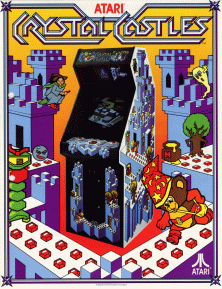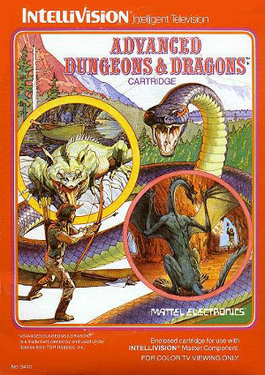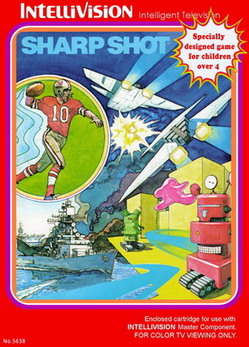
The Intellivision is a home video game console released by Mattel Electronics in 1979. The name is a portmanteau of "intelligent television". Development began in 1977, the same year as the launch of its main competitor, the Atari 2600. In 1984, Mattel sold its video game assets to a former Mattel Electronics executive and investors, eventually becoming INTV Corporation. Game development ran from 1978 to 1990, when the Intellivision was discontinued. From 1980 to 1983, more than 3.75 million consoles were sold. As per Intellivision Entertainment the final tally through 1990 is somewhere between 4.5 and 5 million consoles sold.

BurgerTime, originally released as Hamburger in Japan, is a 1982 arcade video game from Data East released initially for its DECO Cassette System. The player is chef Peter Pepper, who must walk over hamburger ingredients in a maze of platforms and ladders while avoiding anthropomorphic hot dogs, fried eggs, and pickles which are in pursuit.

Crystal Castles is an arcade game released by Atari, Inc. in 1983. The player controls Bentley Bear who has to collect gems located throughout trimetric-projected rendered castles while avoiding enemies, some of whom are after the gems as well.

Bump 'n' Jump is an overhead-view vehicular combat game developed by Data East and originally released in Japan as Burnin' Rubber. Distributed in North America by Bally Midway, the arcade version was available as both a dedicated board and as part of Data East's DECO Cassette System. The goal is to drive to the end of a course while knocking enemy vehicles into the sides of the track and jumping over large obstacles such as bodies of water.

Utopia is a 1982 strategy video game by Don Daglow released for the Intellivision and Mattel Aquarius. It is often regarded as among the first city building games, and credited as "arguably the earliest ancestor of the real-time strategy genre." In July 2010, the game was re-released on Microsoft's Game Room service for its Xbox 360 console and for Games for Windows Live.
An action role-playing game is a subgenre of video games that combines core elements from both the action game and role-playing genre.

Intellivision Lives! is a compilation of over 60 Intellivision video games, originally produced by Mattel Electronics and INTV Corporation between 1978 and 1990. Using original game code and software emulation, Intellivision Productions released the compilation on a Windows and Macintosh hybrid CD-ROM in December 1998. Additional versions were then released for the PlayStation 2, Xbox, and GameCube by Crave Entertainment. In 2010, Virtual Play Games released a Nintendo DS version.

Don Daglow is an American video game designer, programmer, and producer. He is best known for being the creator of early games from several different genres, including pioneering simulation game Utopia for Intellivision in 1981, role-playing game Dungeon in 1975, sports games including the first interactive computer baseball game Baseball in 1971, and the first graphical MMORPG, Neverwinter Nights in 1991. He founded long-standing game developer Stormfront Studios in 1988.

Intellivision World Series Major League Baseball is a baseball video game (1983) designed by Don Daglow and Eddie Dombrower, and published by Mattel for the Intellivision Entertainment Computer System. IWSB was one of the first sports video games to use multiple camera angles and present a three-dimensional perspective. It was also the first statistics-based baseball simulation game on a video game console; all prior console baseball games were arcade-style recreations of the sport.

Dungeons of Daggorath is one of the first real-time, first-person perspective role-playing video games. It was produced by DynaMicro for the TRS-80 Color Computer in 1983. A sequel, Castle of Tharoggad, was released in 1988.

Advanced Dungeons & Dragons: Treasure of Tarmin is a video game for the Intellivision video game console and the Mattel Aquarius computer system. This game was a licensed Dungeons & Dragons adaptation. It is a successor game to Advanced Dungeons & Dragons: Cloudy Mountain (1982).

Advanced Dungeons & Dragons is an Intellivision game and was one of the first Advanced Dungeons & Dragons games to be licensed by TSR, Inc. It was later retitled to Advanced Dungeons & Dragons: Cloudy Mountain to distinguish it from the sequel, Advanced Dungeons & Dragons: Treasure of Tarmin. It is the first Intellivision cartridge to use more than 4K of ROM.
PlayCable was an online service introduced in 1980 that allowed local cable television system operators to send games for the Intellivision over cable wires alongside normal television signals. Through the service, subscribers would use a device, called the PlayCable adapter, to download the games for play on their Intellivision. It was the first service that allowed users to download games for play on a video game console. PlayCable was not widely adopted, due in part to high costs for users and operators, as well as limitations of the PlayCable adapter. The service was discontinued in 1984.

Microsurgeon is a maze-like video game published by Imagic in 1982 for the Mattel Intellivision game console. The game was ported to the TI-99/4A computer and the IBM PCjr. Microsurgeon was re-released as part of the Intellivision Rocks collection.

Dungeons & Dragons Computer Fantasy Game is a handheld electronic game released by Mattel in 1981. Designer Peter Oliphant claims that it was one of the more basic projects he worked on during his career.

Hover Force is a video game published by INTV Corporation for the Intellivision video game system in 1986. The game was initially developed by Mattel Electronics with the intent of it being played in 3-D, but the company was shut down before it could be released; INTV, after acquiring the Intellivision assets from Mattel, re-tooled the game, which pits players against a terrorist group laying siege to a city, and released it itself.

Skiing is a sports video game produced by Mattel and released for its Intellivision video game system in 1980. Up to six players compete individually on either a downhill or slalom course to see who can complete the course the fastest. For the game's initial release, Mattel obtained a license from the U. S. Ski Team and used its name and logo in the game's box art. In 1988, INTV Corporation released an enhanced version of the game entitled Mountain Madness: Super Pro Skiing.

Sharp Shot is a video game released by Mattel for its Intellivision video game system in 1982. Specifically marketed towards younger children, Sharp Shot is a collection of four simple games where the object is to score points by correctly timing shots at various targets.

















